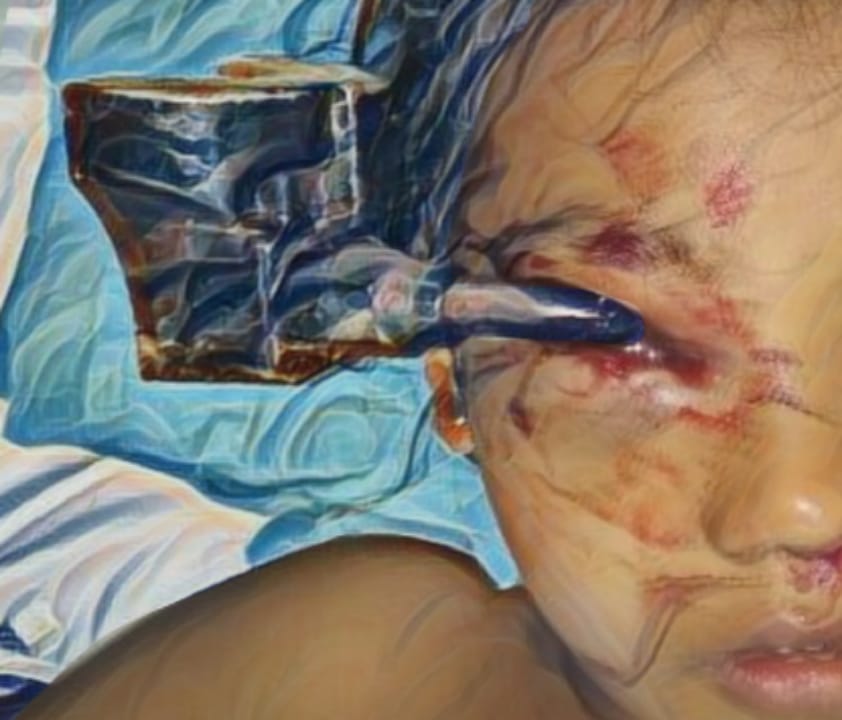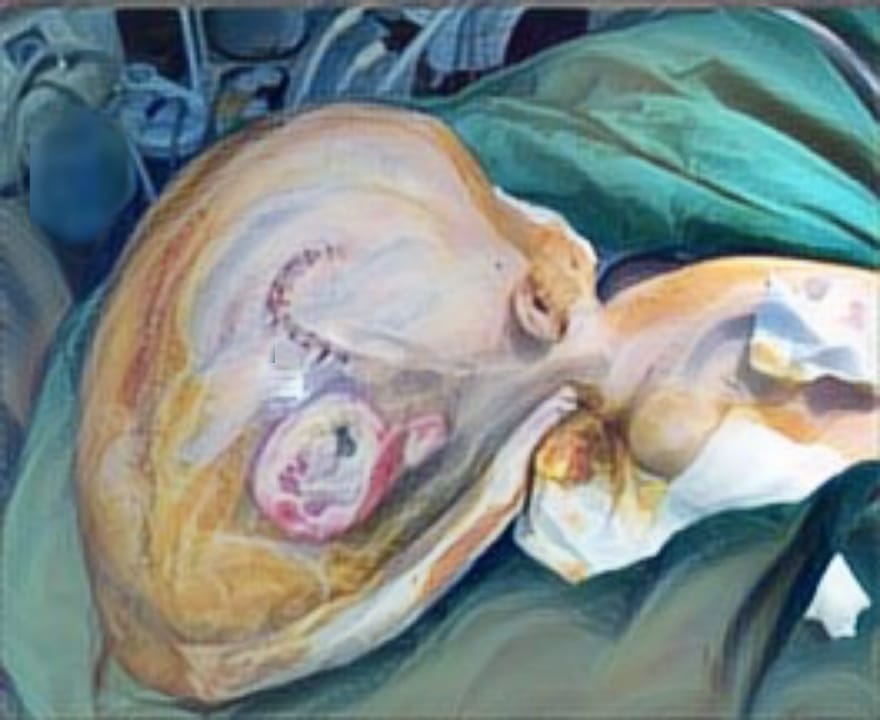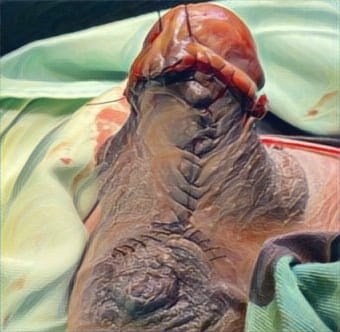RECONSTRUCTION OF CHIN DEFECT POST BASAL CELL CARCINOMA EXCISION USING RHOMBOID FLAP: A CASE REPORT

Downloads
Highlights:
- BCC is strongly associated with UV radiation exposure,commonly affecting the face, but the chin is rarely involved (1.2% incidence).
- Chin reconstruction after BCC excision is challenging, requiring careful flap selection for function and aesthetics.
- The rhomboid flap is a preferred choice, offering good blood supply, minimal tension, quick healing, and better cosmetic results.
Abstract:
Introduction: Basal cell carcinoma (BCC) is a malignant skin tumor with the highest incidence and originates from the basal cells of the epidermis, with the nodular type being the most common.
Case Illustration: A 76-year-old female patient came with complaints of a lump on the chin that had enlarged and bled easily for 3 years before entering the hospital. The patient was diagnosed with Basal Cell Carcinoma in the chin region.
Discussion: Wide excision was performed under local anesthesia, then the wound was closed with a rhomboid flap. Evaluation after 1 month post-operatively the wound closed well and the scar was disguised.
Conclusion: The chin is a unique aesthetic area with unique contours and shapes, making it a challenge for plastic surgeons to perform reconstruction after extensive BCC excision. The rhomboid flap is a very versatile local flap because it can be used almost anywhere on the body, including the chin.
Mawardi P, Kalim H, Kalim KH, Fitri LE, Mintaroem K, Mudigdo A, et al. Mid-face location of primary basal cell carcinoma related to cancer aggressivity. Asian Pac J Trop Dis. 2016; 6(8): 650–653. DOI: 10.1016/S2222-1808(16)61103-9.
Kumar S, Mahajan BB, Kaur S, Yadav A, Singh N & Singh A. A study of Basal cell carcinoma in South Asians for risk factor and clinicopathological characterization: a hospital-based study. J Skin Cancer. 2014; 2014: 173582. DOI: 10.1155/ 2014/173582.
Lomas A, Leonardi-Bee J & Bath-Hextall F. A systematic review of worldwide incidence of nonmelanoma skin cancer. Br J Dermatol. 2012;166(5):1069–1080. DOI: 10.1111/j.1365-2133.2012.10830.x.
Pathirana TH, Bandaranayake V, Nellihela AP, Nikeshala S, Saranga T, Abegunasekara A, et al. The versatile art of reconstruction: A decade‐long journey with recurrent facial basal cell carcinoma. Cancer Rep. 2025; 8(1):e70124. DOI: 10.1002/cnr2.70124.
Marzuka AG & Book SE. Basal cell carcinoma: Pathogenesis, epidemiology, clinical features, diagnosis, histopathology, and management. Yale J Biol Med. 2015; 88(2): 167–179. PMID: 26029015.
Sekulic A, Migden MR, Oro AE, Dirix L, Lewis KD, Hainsworth JD, et al. Efficacy and safety of vismodegib in advanced basal-cell carcinoma. N Engl J Med. 2012; 366(23): 2171–2179. DOI: 10.1056/ NEJMoa1113713.
Lua ACY, Oh DAQ, Tow HXS, Por RH, Koh HY & Oh CC. Mohs micrographic surgery for basal cell carcinoma in Singapore: A retrospective review. JAAD Int. 2024; 17: 167–169.DOI:10.1016/j.jdin.2024.07.016.
Peris K, Fargnoli MC, Garbe C, Kaufmann R, Bastholt L, Seguin NB, et al. Diagnosis and treatment of basal cell carcinoma: European consensus-based interdisciplinary guidelines. Eur J Cancer. 2019; 118: 10–34. DOI: 10.1016/j.ejca. 2019.06.003.
Tan ST & Reginata G. Diagnosis dan Tatalaksana Karsinoma Sel Basal. Cermin Dunia Kedokteran. 2015; 42(12):399790. DOI: 10.55175/cdk.v42i12.932.
Bader RS. Basal cell carcinoma. [Online] Available from: http://emedicine.medscape.com/article/276624-overview [Accessed on September 15th, 2015].
Arisanty R, Habiburrahman M & Putri MA. Clinicopathologic and histomorphological aspect of basal cell carcinoma in Dr. Cipto Mangunkusumo Hospital: A retrospective analysis of twenty years experience. EJKI. 2021; 9(2): 118. DOI: 10.23886/ejki.9.34. 118.
Janjua OS & Qureshi SM. Basal cell carcinoma of the head and neck region: an analysis of 171 cases. J Skin Cancer. 2012; 2012(1): 943472. DOI: 10.1155/ 2012/943472.
Kantor J. The epidemiology of skin cancer in Asia. J Am Acad Dermatol. 2021;85(3): 569. DOI: 10.1016/j.jaad. 2021.07.008.
Wojtowicz I & Żychowska M. Dermoscopy of basal cell carcinoma Part 1: Dermoscopic findings and diagnostic accuracy—A systematic literature review. Cancers. 2025; 17(3):493. DOI: 10.3390/ cancers17030493.
Teng Y, Yu Y, Li S, Huang Y, Xu D, Tao X, et al. Ultraviolet radiation and basal cell carcinoma: an environmental perspective. Front Public Health. 2021;9:666528. DOI: 10.3389/fpubh.2021.666528.
Pfeifer GP. Mechanisms of UV-induced mutations and skin cancer. Genome Instab Dis. 2020; 1(3):99–113. DOI: 10.1007/ s42764-020-00009-8.
Salido-Vallejo R, Antoñanzas J, Gómez-Arias P & Aguado L. Double subcutaneous island pedicle flap for reconstruction of large upper and central chin defects. J Dtsch Dermatol Ges. 2024; 22(5):727–729. DOI:10.1111/ddg.15383.
Lee SO, Kim TG & Chung KJ. Minimizing surgical margins in basal cell carcinoma: A single institution's experience with excision and reconstruction methods. Arch Plast Surg. 2025; 52(1): 30-35. DOI:10.1055/s-0044-1788780
Der Sarkissian S. Histological clearance and recurrence of keratinocyte cancers. DermNet NZ 2020. Retrieved from https://dermnetnz.org/topics/histological-clearance-and-recurrence-of-keratinocyte-cancers
Quazi SJ, Aslam N, Saleem H, Rahman J & Khan S. Surgical margin of excision in basal cell carcinoma: a systematic review of literature. Cureus. 2020; 12(7):e9211. DOI:10.7759/cureus.9211
Nahhas AF, Scarbrough CA & Trotter S. A review of the global guidelines on surgical margins for nonmelanoma skin cancers. J Clin Aesthet Dermatol 2017; 10(4): 37. PMID:28458773
Kiely JR & Patel AJK. A retrospective study of 694 basal cell carcinoma excisions to quantify deep margin documentation and clearance compared to histological type and surgical margin. J Plast Reconstr Aesthet Surg. 2019; 72(11): 1805-1812. DOI:10.1016/j.bjps.2019.06. 002
Widiatmoko A, Yuniaswan AP, Nahlia NL & Retnani DP. Excision with rhomboid flap on nasal basal cell carcinoma. J Dermatol Venereol Aesthet. 2023;3(2):1-7.
Jenkins SD & Lequeux-Nalovic KG. Reconstruction of chin defects using an O to Z bilateral rotation flap. J Cosmet Dermatol Sci Appl. 2012;2:41–44.
Chan R, Li CL, Liu D, Luk NM, Young A, Choi P, et al. Mohs surgery for periocular basal cell carcinoma without a Mohs surgeon: the first series in Hong Kong. Cureus. 2023; 15(3): e36235. DOI:10.77 59/cureus.36235
Gutzmer R & Solomon JA. Hedgehog pathway inhibition for the treatment of basal cell carcinoma. Target Oncol. 2019; 14(3): 253–267. DOI: 10.1007/s11523-019-00648-2.
Caro I & Low JA. The role of the hedgehog signaling pathway in the development of basal cell carcinoma and opportunities for treatment. Clin Cancer Res. 2010; 16(13): 3335-3339. DOI:10.1158/1078-0432.CCR-09-2570
Chmiel P, Kłosińska M, Forma A, Pelc Z, Gęca K & Skórzewska M. Novel approaches in non-melanoma skin cancers—A focus on Hedgehog pathway in basal cell carcinoma (BCC). Cells. 2022; 11(20):3210. DOI:10.3390/cells112032 10
Jacobsen AA, Aldahan AS, Hughes OB, Shah VV & Strasswimmer J. Hedgehog pathway inhibitor therapy for locally advanced and metastatic basal cell carcinoma: a systematic review and pooled analysis of interventional studies. JAMA Dermatol. 2016;152(7):816-824. DOI:10.1001/jamadermatol.2016.0780
Jacobsen AA, Kydd AR & Strasswimmer J. Practical management of the adverse effects of Hedgehog pathway inhibitor therapy for basal cell carcinoma. J Am Acad Dermatol. 2017; 76(4): 767-768. DOI:10.1016/j.jaad.2016.04.063
Patel S, Armbruster H, Pardo G, Archambeau B, Kim NH, Jeter J, et al. Hedgehog pathway inhibitors for locally advanced and metastatic basal cell carcinoma: A real-world single-center retrospective review. PLoS One. 2024; 19(4): e0297531. DOI:10.1371/journal. pone.0297531
Farberg AS, Portela D, Sharma D & Kheterpal M. Evaluation of the tolerability of Hedgehog pathway inhibitors in the treatment of advanced basal cell carcinoma: A narrative review of treatment strategies. Am J Clin Dermatol. 2024; 25(5): 779-794. DOI:10.1007/ s40257-024-00870-3
Silapunt S, Chen L & Migden MR. Hedgehog pathway inhibition in advanced basal cell carcinoma: latest evidence and clinical usefulness. Ther Adv Med Oncol. 2016; 8(5): 375-382. DOI:10.1177/17588340 16653605
Josh, F., Mappiwali, A & Sukamto, T. H. EVALUASI KASUS KARSINOMA SEL BASAL DI MAKASSAR PERIODE JANUARI 2017-DESEMBER 2019. Jurnal Rekonstruksi Dan Estetik, 2021;6(2):57–64. DOI: 10.20473/jre.v6i2.31834
Sciegienka S, Hanick A & Branham G. Rotation and transposition flaps in facial plastic and reconstructive surgery. Plast Aesthet Res. 2022;9:1. DOI: 10.20517/ 2347-9264.2021.76.
Agrawal NK. Revisiting rhombic flaps for aesthetic facial resurfacing: Addressing a surgical conundrum. J Cutan Aesthet Surg. 2021; 14(3): 330–336. DOI: 10.4103/ JCAS.JCAS_63_20.
Bednarek RS, Sequeira Campos M, Hohman MH & Ramsey ML. Transposition flaps. StatPearls. 2023.
dos Santos AD, Haddad Filho D, Marcelino FFN & Vieites L. Applicability of the Limberg Flap: a case series. Surg Cosmet Dermatol. 2022; 14: e20220079. DOI: 10.5935/scd1984-773.2022140079.
Hon HH & Chandra SR. Rhomboid flap. Atlas Oral Maxillofac Surg Clin North Am. 2020; 28(1):17–22. DOI: 10.1016/j.cxom. 2019.11.005.
Macneal P & Adlard RE. Rhombic flaps. StatPearls. 2023 Jun 26.
Kang AS & Kang KS. Expanding the scope of rhomboid flap: large cutaneous defect reconstruction. Case report. Ann Med Surg (Lond). 2021;62:369–372. DOI: 10.1016/j.amsu.2021.01.082.
Raju PV, Ahmed IT, Preethi A & Mahipathy SRRV. Limberg flap revisited: for closure of facial soft tissue defects. Int Surg J. 2023;10:918-921. DOI:10.18203/ 2349-2902.isj20231067
Kang AS & Kang KS. Assessment of rhomboid flap scars: A patient-reported outcome study. Ann Med Surg (Lond). 2022; 75: 103328. DOI: 10.1016/j.amsu. 2022.103328.
Kang AS & Kang KS. Rhomboid flap: Indications, applications, techniques and results. Ann Med Surg (Lond). 2021; 68:102544. DOI:10.1016/j.amsu.2021. 102544.
Copyright (c) 2025 Yeremia Maruli Togatorop, Saktrio D. Subarno

This work is licensed under a Creative Commons Attribution-ShareAlike 4.0 International License.
JURNAL REKONSTRUKSI DAN ESTETIK by Unair is licensed under a Creative Commons Attribution-ShareAlike 4.0 International License.
- The journal allows the author to hold copyright of the article without restriction
- The journal allows the author(s) to retain publishing rights without restrictions.
- The legal formal aspect of journal publication accessbility refers to Creative Commons Attribution Share-Alike (CC BY-SA)



















